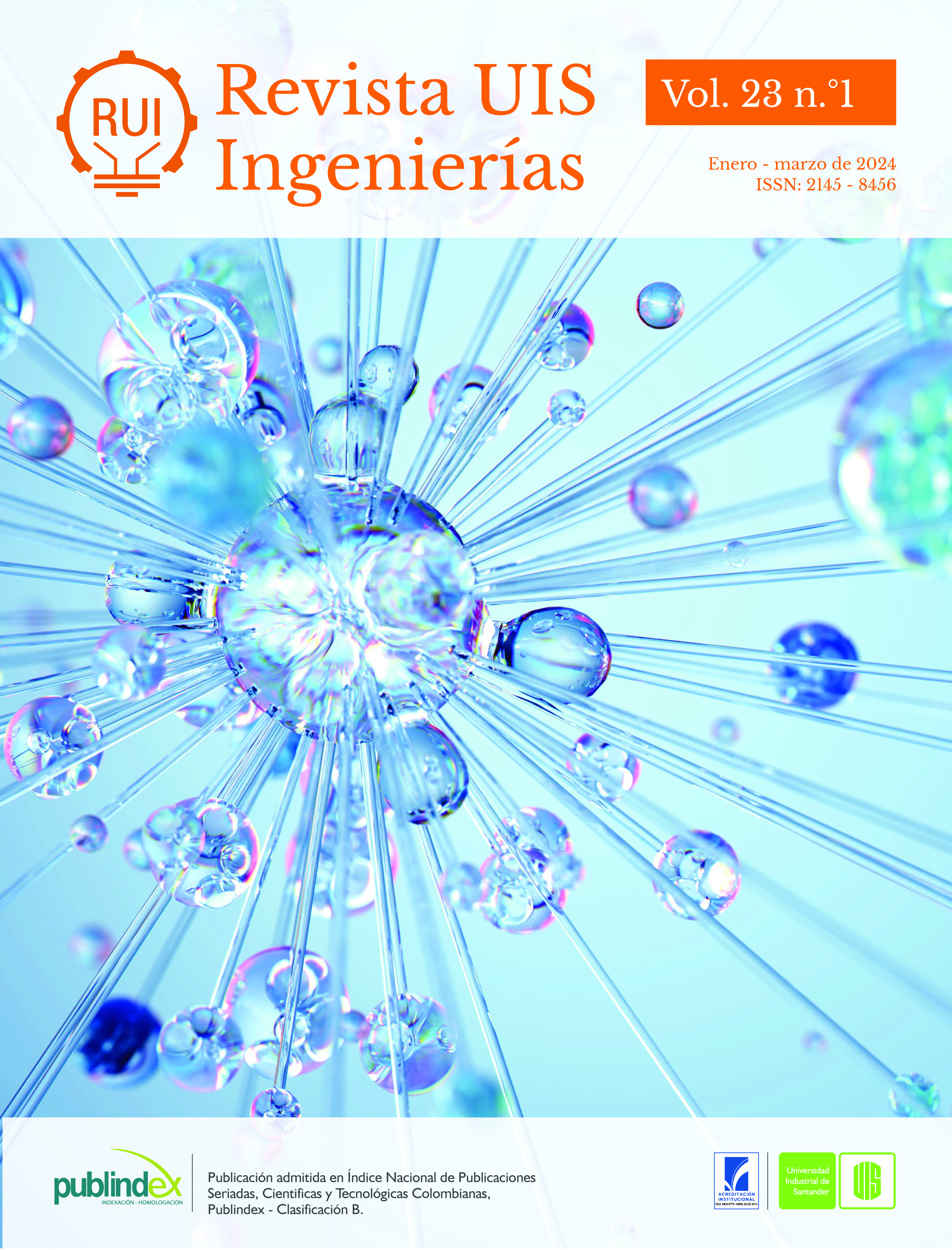Published 2024-02-20
Keywords
- Convergence Sensitivity Analysis -CSA-,
- DERs-Load flow,
- Distributed Energy Resources (DERs),
- Radial network,
- Scaling Factor
- R / X Ratio ...More
How to Cite
Copyright (c) 2024 Revista UIS Ingenierías

This work is licensed under a Creative Commons Attribution-NoDerivatives 4.0 International License.
Abstract
During the electric power system (EPS) modelling with massive use of distributed energy resources (DERs) - distributed generation (DG), storage and other distributed technologies such as electric vehicles - simplified and ideal conditions are assumed for the active distribution network. From the grid side, these elements are modelled as absorption and injection of power and/or current. In this paper, using the model MV-Benchmarck System CIGRE Task Force C6.04, a comparative analytical straightforward algorithm of convergence limits on load flow based on sum of powers and sum of currents along the topological matrix has been simulated. The convergence sensitivity analysis was examined for 3 system characteristics: radial and meshed Configuration, DG penetration and R/X ratio, finding percentage differences of up to 6% convergence sensitivity by power hosting capacity between two -non-linear- methods used for load flow.
Downloads
References
- B. Muruganantham, R. Gnanadass, N. P. Padhy, “Performance analysis and comparison of load flow methods in a practical distribution system,” 2016 National Power Systems Conference (NPSC), Bhubaneswar, India, 2016, doi: https://doi.org/10.1109/NPSC.2016.7858848
- C. Cheng, F. Zhang, “A Modified Newton Method for Radial Distribution System Power Flow Analysis,” IEEE Transactions on Power Systems, vol. 12, nº 1, pp. 389 - 397, 1997, doi: https://doi.org/10.1109/59.575728
- Z. Aboelsood, E. F. El-Saadany, “Effect of Network Configuration on Maximum Loadability and Maximum Allowable DG penetration in Distribution Systems,” IEEE Electrical Power & Energy Conference (EPEC), Halifax, NS, Canada, 2013, doi: https://doi.org/10.1109/EPEC.2013.6802952
- M.C. Alvarez-Herault, N. N’Doye, C. Gandioli, N. Hadjsaid, P. Tixador, “Meshed distribution network vs reinforcement to increase the distributed generation connection,” Sustainable Energy, Grids and Networks, vol. 1, nº 1, pp. 20-27, 2015, doi: https://doi.org/10.1016/j.segan.2014.11.001
- D. Openshaw, G. Strbac, G. Ault, “Distributed energy resources and efficient utilisation of electricity,” CIRED 2009 - The 20th International Conference and Exhibition on Electricity Distribution - Part 2, Prague, 2009.
- J. M. López Lezama, L. A. Gallego Pareja, “Flujo de potencia óptimo usando método del gradiente para reducción de las pérdidas en sistemas de potencia,” Ingeniería y Ciencia, vol. 4, nº 7, pp. 71-85, 2008.
- D. Wolter, Z. Markus, M. Stötzel, “Impact of meshed grid topologies on distribution grid planning and operation,” 24th International Conference & Exhibition on Electricity Distribution (CIRED), Glasgow, Scotland, 2017, doi: http://dx.doi.org/10.1049/oap-cired.2017.0708
- M. Bollen, F. Hassan, Integration of distrituted generation in the power system. Hoboken, New Jersey: Institute of Electrical and Electronic Engineers, 2011.
- U. H. Ramadhania, M. Sheperoa, J. Munkhammara, Joakim Widéna, “Review of probabilistic load flow approaches for power distribution systems with photovoltaic generation and electric vehicle charging,” International Journal of Electrical Power and Energy Systems, nº 120, 2020.
- E. Mulenga, “Solar PV Stochastic Hosting Capacity Assessment Considering Epistemic (E) Probability Distribution Function (PDF),” Electricity, vol. 3, nº 4, p. 586–599, 2022, doi: https://doi.org/10.3390/electricity3040029
- U. D. Lubo, “Cargos de respaldo por uso de la red eléctrica en el costo unitario de energía distribuida: desafíos y oportunidades para la planificación,” Revista UIS Ingenierías, vol. 18, nº 3, pp. 67-74, 2019, doi: https://doi.org/10.18273/revuin.v18n3-2019007
- E. Ghiani, G. Pisano, “Chapter 2- Impact of Renewable Energy Sources and Energy Storage Technologies on the Operation and Planning of Smart Distribution Networks,” Operation of Distributed Energy Resources in Smart Distribution Networks, S. N. Kazem Zare, Ed., Cagliari, Italy, Elsevier, 2018, pp. 25-48, doi: https://doi.org/10.1016/B978-0-12-814891-4.00002-3
- Electric Power Research Institute, “Impact factors, methods, and consideration for calculation and applying Hosting Capacity.,” EPRI, Palo Alto, California, USA, 2018.
- L. A. Gallego, J. M. Lopez-Lezama, D. Mejía-Giraldo, “Flujo de potencia trifásico desbalanceado en sistemas de distribución con generación distribuida,” Scientia et Technica, vol. 3, nº 43, pp. 43-48, 2009.
- K. Balamurugan, D. Srinivasan, “Review of power flow studies on distribution network with distributed generation,” IEEE Ninth International Conference on Power Electronics and Drive Systems, Singapore, 2011.
- DIgSILENT GmbH, DIgSILENT PowerFactory - User Manual, Online Edition ed., Gomaringen, Germany, 2019.
- CIGRE, TF C6.04.02: TB 575 - Benchmark Systems for Network Integration of Renewable and Distributed Energy Resources, Paris, FR: Task Force C6.04 CIGRE, 2014.

